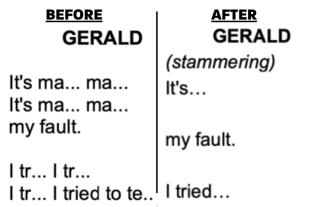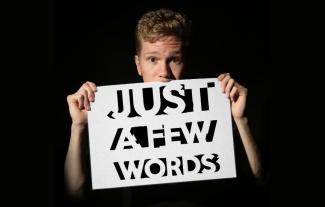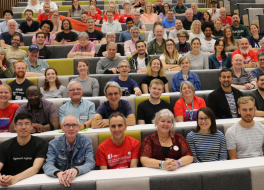Learning how to portray stammering for my play

For her play Tall Storey, writer Jenifer Toksvig consulted a person who stammers to ensure the portrayal of one of her characters was authentic. Here, she tells us what she learnt from the experience.
Like all writers, I have a bottom drawer of things that never achieved production. But I love all of them, and I recently began sharing them on my Substack as Theoretical Theatre.
One of them is a short play I wrote in verse, set on the roof of an office block, called Tall Storey. Each of the three characters has their own specific rhythms. One of them, Gerald, stammers. It is part of the narrative: the disfluency of his speech is the reason the story starts and ends.
When I wrote it, some twenty years ago, I didn't even think to consult someone who stammers. I don't remember considering whether the role would be played by a performer who has any kind of speech disfluency. I made choices about which words would be inhibited, and how — which limits the options to a speech-fluent performer.
I wasn't going to put it out there if it was yet another piece of writing that does harm to people who stammer.
When I came to revisit it, I knew I wanted to consult with someone first. Primarily, I wasn't going to put it out there if it was yet another piece of writing that does harm to people who stammer.
Theatre maker Nye Russell-Thompson of StammerMouth theatre company kindly agreed to consult, and it was, of course, eye-opening. No matter how informed and aware you think you are as a human being, there really is no way to understand someone else's lived experience. The best you can do is ask them, and then listen.
Nye talked so insightfully and articulately about what it is to be a person who stammers. From our conversation, I made many small but really significant changes to the script.
I took out all the places in which I had stipulated a specific stammer on a word. For instance, instead of putting 'ma…ma…my' in the script, I added the stage direction '(stammering)' before the line (see the image below for an example). This was the most obvious change, to present the lines for authentic performance.

Tightly rhythmic work can make performers feel strictly bound to the rhythm, so it's been delightful to give the work this kind of rhythmic flexibility, thanks to Nye's understanding of both speech disfluency and theatrical storytelling.
Navigating the complexities
It wasn't entirely straightforward, though. At one point, Gerald has an internal monologue — and I was really interested to know from Nye whether he stammers in his thoughts too. I know that some people have an internal monologue and others don't (of which I am one). We talked about there being the same diversity with regard to stammering, so I felt able to make the choice of no stammering in Gerald's internal monologue.
I've set certain spoken lines for Gerald as being delivered fluently. They are all one-word lines, delivered within a fast-rhythm section, sometimes where a rhyme needs to neatly land. There's also one line he repeats multiple times because he cannot finish a particular word.
It’s been delightful to give the work this kind of rhythmic flexibility, thanks to Nye's understanding of both speech disfluency and theatrical storytelling.
Nye talked about how people with speech disfluency are constantly working to have some agency over their contributions to conversations. This makes complete sense to me as a neurodivergent person who is constantly trying to regulate my interactions with others, but even though I have that in my own lived experience, it wasn't until Nye talked about it that I realised the effect it would have here, on both character and performer.

Much of this play is frantic three-way dialogue. Gerald's internal monologue gives the piece a more fluent moment with just one voice — and I wanted him to have a moment of uninterrupted freedom to speak.
But I'm also aware that these specific choices would present challenges to an actor who stammers. Being one of those, Nye felt that it would be a really interesting process for him. And whilst I want to be considerate, I also don't want to be patronising. Consulting with Nye helped me navigate all of these complexities in a more informed and considered way that I hope has resulted in a better balance within the work.
This play was supposed to be a musical, but I found the difference in the spoken rhythms of the three characters so fascinating that I actually prefer it as a play. Nye made this great observation about rhythm in his response:
"And, while we don't perceive there to be a strict rhythm we must speak to in day-to-day life, like in Tall Storey, some people who stammer certainly DO feel that way. We have an arbitrary rhythm we feel such intense pressure to adhere to every day, because from our perspective, people who speak without disfluency or impediment follow this rhythm. If we speak out of rhythm with it, then we are seen *too much* with the spotlight brightly shining upon us, for all to criticise, or even just to point out, like they're so very observant."
I've always loved the rhythms in everyday speech, and I agree with Nye when he says that he would love to see more productions casting people with atypical speech patterns. I'd like to write more rhythmic work for casts with diverse speech fluency, too. The way we communicate with one another is a complexity of components, including things like prosody — the musical intonations we use to convey meaning, of which rhythm is also a part.
As for Tall Storey, you can download the script to read for free on Substack. Thanks to Nye, I was able to add some clarifying notes at the start, and you can read his response.
If I could, I would bring this script into an open rehearsal process with a cast that includes someone who stammers playing Gerald… and indeed, playing the other characters. For me, that would be a great exploration of speech rhythm and disfluency. It's a short play — maybe twenty minutes long, which is the perfect length for an open rehearsal that could be livestreamed or recorded.
Give me a shout if you know of a way to support such a thing. And check out Nye's brilliant theatre making.
If you think you can help with Jenifer's request, email us at editor@stamma.org and we'll pass your message on.
Read more about Nye in the article he wrote about his one-man theatre show Just a Few Words.
Read more Your Voice stories. Would you like to write an article? See Submit Something For The Site or email editor@stamma.org

































